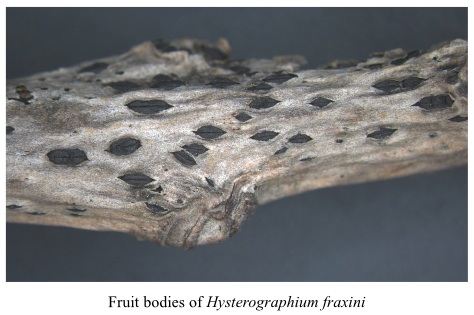PESTS AND DISEASES OF FORESTRY IN NEW ZEALAND
Hysterographium
Scion is the leading provider of forest-related knowledge in New Zealand
Formerly known as the Forest Research Institute, Scion has been a leader in research relating to forest health for over 50 years. The Rotorua-based Crown Research Institute continues to provide science that will protect all forests from damage caused by insect pests, pathogens and weeds. The information presented below arises from these research activities.
Forest Health News 149, March 2005.
In December last year, as a result of a public enquiry regarding dieback of Fraxinus excelsior in Timaru, a Northern Hemisphere fungus was recorded in New Zealand for the first time. It is Hysterographium fraxini and its occurrence here was reported in the February issue of “Biosecurity” (Issue 57) with the comment that Biosecurity New Zealand is carrying out an initial investigation to assess whether further actions are required against the fungus.
The fruit bodies of H. fraxini (see below), which are found on dead branches and twigs, are very distinctive and have been likened to “smiley lips”. When the sample was being examined in the laboratory there were so many oohs and aahs from the pathologists that a normally staid entomologist had to go over and duly admire the specimen under the stereo microscope.

In the Northern Hemisphere H. fraxini is generally recorded as a non-specialised, facultative saprophyte. In Switzerland in the 1940s it was reported that H. fraxini might be responsible for extensive damage to ash ( Fraxinus excelsior and F. ornus ) under conditions adverse to the host, e.g., humid sheltered situations or water-logged soils. The fungus enters branches of any age through fresh wounds in the spring and at first develops saprophytically, but later it may encroach on the surrounding living tissue. Towards the end of the summer the leaves above the site of infection begin
to wither, since by this time the branch is almost completely girdled. In vigorous trees the formation of callus between the upper and lower parts of the branch arrests further growth. Re-infection
can occur only through a fresh injury in healthy trees, but in trees which are seriously weakened and where no callus is formed the fungus may pass from the already invaded branches to sound ones
and finally to the trunk. More recent references from Switzerland and England describe the fungus as “rare”.
Since the initial find in South Canterbury, H. fraxini has been found in mid-Canterbury, Marlborough, Marlborough Sounds, Nelson, Wellington, and Wairarapa on Fraxinus excelsior, F.angustifolia, F. ornus, and Fraxinus sp. Its behaviour in New Zealand is that of a saprophtye. The dieback of the tree in Timaru was probably caused by high numbers of Acizza sp. (Psyllidae).
(John Bain, Editor, based on information supplied by Margaret Dick. Forest Research)
This information is intended for general interest only. It is not intended to be a substitute for specific specialist advice on any matter and should not be relied on for that purpose. Scion will not be liable for any direct, indirect, incidental, special, consequential or exemplary damages, loss of profits, or any other intangible losses that result from using the information provided on this site.
(Scion is the trading name of the New Zealand Forest Research Institute Limited.)

 Farm Forestry New Zealand
Farm Forestry New Zealand

